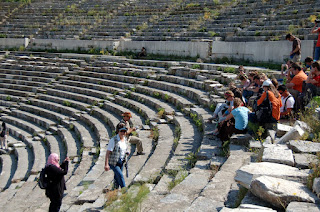 |
| Theater at Miletus |
After Ephesus we were all tired, but hey there was another ancient site to visit. Miletus was an ancient Greek city on the western coast of Anatolia. Before the Persian invasion, Miletus was considered the greatest and wealthiest of Greek cities.
 |
| Look at Miletus from theater |
By the time the Apostle Paul visited Miletus at the conclusion of his third and final journey, he was hurrying to arrive in Jerusalem in time for Pentecost (Acts 20:16). He had bypassed Ephesus (I am glad we didn't), where his past connections would have obligated him to spend a considerable amount of time. He summoned the elders from Ephesus to meet him and delivered a lengthy (Paul's style just ask Eutychus from Troas who fell from a window) and poignant farewell speech (Acts 20:17-35) At the conclusion he quoted an otherwise unknown saying of Jesus that has become famous, "It is more blessed to give then to receive"
 |
| Polat Thermal Hotel |
We stayed the night at Polathotel about 5 km from Pamukkale (Ancient Hierapolis). The highlight here was the swimming pool and the students took advantage. Alas, Christine and I had left our swim suits in Jerusalem. The spa was an option, but having a thick armed Turk rub me down while laying there in nothing but a towel wasn't too exciting.
 |
| Travertine Terraces of Pamakkule |
Pamukkale (Cotton Castle) is the modern site of the ancient Hierapolis. The terraces are Travertine which I am told is a white sedentary rock deposited by water from hot springs. There are 17 hot water springs. I took off my shoes and walked into the nice warm water, braving my way through bikini clad visitors. I fail to see how fat, old people look good in bikinis or speedos
Hierapolis "the sacred city" In the first century it was part of the tri-city area of Laodicea, Colossae, and Hierapolis. This connection between the cities lies behind Paul’s reference to Hierapolis and Laodicea in his epistle to the Colossians (Col 4:13). Laodicea was known for cold springs and Hierapolis for it's hot springs and Colossae was chastised for being lukewarm
 |
| Apollo Temple |
Remains of the Apollo Temple. Its foundations date to the Hellenistic period, but the structure itself was built in the 3rd century A.D. Apollo was thought to be the city’s divine founder. The temple was built beside the plutonium, an underground cavern from which poisonous gases emerged. The city’s theater stands in the background.
 |
| Nymphaeum |
The Nymphaeum is located inside the sacred area, in front of the Apollo temple. It dates from the 2nd century CE. It was a shrine of the nymphs, a monumental fountain distributing water to the houses of the city via an ingenious network of pipes.
 |
| Antique Pool |
the Antique Pool's water is good for heart diseases, atherosclerosis, blood pressure, rheumatism, eye and skin diseases, rickets, nervous disorders, nervous and physical exhaustion circulatory problems and furthermore when it has been drank it is good for digestive maladies. Unfortunately, all the speedos and bikinis increase digestive maladies
 | |
| View of Travertine Terraces |
|
|
|
|
|
|
We made a 15 minute photo op at Thyatira, the modern Turkish city of Akhisar ("white castle") and managed to avoid a bathroom stop which would have changed it to a 45 minute stop.
 |
| Thyatira | | | | |
In Acts 16, Paul and Silas traveled to Philippi where they met a woman named Lydia, who is described as "from the city of Thyatira and a dealer in purple cloth."(16:14) She is considered to be the first Christian convert on European soil. In Revelation 2, Jesus sends a message to the church in Thyatira praising them. However, there was a problem with the support of a woman symbolically called Jezebel, considered a false prophet and seducer who led the people astray, causing them to "eat food sacrificed to idols" and to "commit adultery with her" (metaphor for leading them to be unfaithful to God)























































